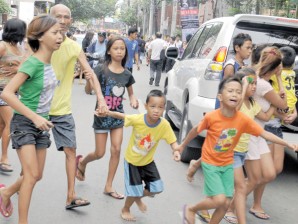
QUAKE PANIC Residents in Cebu City run scared as reports of a tsunami swept the city after a 6.9-magnitude earthquake shook the Central Visayas metropolis on Monday. The earthquake’s epicenter was placed near Tayasan town in Negros Oriental. The Philippines lies in the Pacific “Ring of Fire” and is prone to earthquakes and volcanic eruptions. AFP
CEBU CITY—“I couldn’t help but feel eerie because people were crying. I started to get scared, too.”
Radio technician Nilo Borrinaga was collecting his wits after being suddenly caught in the mad rush of people while walking on Colon Street following “reports” that a tsunami hit the downtown area.
The fear triggered panic in the city’s major streets as shoppers, office workers, students and even beggars and the usual strollers scrambled in different directions.
Those who stayed on the streets around Fuente Osmeña Rotunda after a 6.9-magnitude earthquake rocked Cebu and Negros shortly before noon Monday were swept to nowhere though the historical landmark was more than a kilometer away from the sea where a tsunami could have originated.
The scare apparently was triggered by a precautionary tsunami alert issued by the Philippine Institute of Volcanology and Seismology (Phivolcs) that advised people living in the coastline to be vigilant of any rise in the water level. It was lowered two hours later.
The Hawaii-based Pacific Tsunami Warning Center said there was no danger of a widespread destructive tsunami.
Coast Guard directive
In Manila, the Philippine Coast Guard (PCG) immediately suspended the movement of all ships and other water vessels over some parts of Visayas and Northern Mindanao following the tsunami alert.
“We have directed our units not to allow any ships and other water craft to sail or to venture out to sea while the tsunami alert is still raised,” the PCG commandant, Vice Admiral Edmund Tan, said Monday.
All PCG units in the area of the earthquake were directed to issue tsunami warnings in coastal barangays (villages) of Negros Oriental and Cebu, Tan said.
But “reports” suddenly spread through mobile phone text messages that seawater had reached Colon in downtown Cebu and SM City at the North Reclamation Area.
Minutes later, scores of people were running in panic at Fuente Osmeña, the Capitol area, outside Ayala Center Cebu, V. Rama Avenue and in Barangays Guadalupe, Tisa and Pardo. Hotel guests scrambled to higher floors, according to Agence France-Presse.
“We didn’t check whether the talks were true or not because our first reaction was to go to higher ground,” Borrinaga said.
Prayers to Sto. Niño
He said he followed a throng of people inside Basilica Minore del Sto. Niño to pray for protection. “I told myself that if Sto. Niño would allow a tsunami to hit the city, at least I am in His house,” he said.
Representative Tomas Osmeña of the south district went on air in radio stations dyLA and dyAB to ask the people to calm down. He explained that it was impossible for the city to be hit by tsunami like what happened in Japan last year.
Traffic was heavy as vehicles could not pass through. Several cars were seen going up to the mountain barangays.
Five accidents at South Coastal Road, MJ Cuenco Avenue and C. Padilla Street were recorded after motorists defied the traffic flow.
Some people on the street were praying the rosary. Others were crying.
“There is news going around of tsunami waves, so we are doing our best to keep everybody calm,” said Barbi Patino, a spokesperson for the 17-story Parklane International Hotel.
“We are completely safe inside the hotel, but we could see people on the streets rushing away from the area,” he added.
Pedro Baldomino, a student in Cebu, said he saw many office workers in downtown Cebu leaving their buildings after a public announcement on radio warned people to brace for expected aftershocks.
“I was having lunch when the ground shook. Water spilled from glasses and plates clanked. Some of the diners rushed outside, some of us stayed underneath the tables,” he said.
Cops, too
RJ Lechido, 28, a public utility jeepney driver, said he asked someone what happened and was told that a tsunami was about to hit Tisa. When he noticed that uniformed policemen on board motorcycles were in the crowd, he followed them toward South Hills, a hilly portion of the barangay.
“Who would not be scared of a tsunami? I don’t want to be among those who would drown,” Lechido said.
RJ Leduna of SM City said that when the earthquake hit at 11:49 a.m., the management had advised shoppers to leave the building for safety reasons. “We resumed normal operations at 1 p.m. There was no reported injury or damage to property,” he said.
Buildings managed by Cebu Holdings Inc. and most of those within its properties—Cebu Business Park and Cebu IT Park—were emptied after the earthquake.
“We did initial building assessments before people were allowed reentry,” Elson Homez, head of Cebu Holdings property management, said in a statement. “So far, we have not received information of damages or injury to personnel.”
Stranded commuters
The panic eventually subsided, but people found themselves walking to get home because few jeepneys were plying their routes.
Mayor Mike Rama ordered the deployment of city-owned buses to ferry the stranded passengers.
In Carcar City, about 300 families living in the coastal sub-villages of Barangay Perrelos were brought to Perrelos Elementary School, said Junafe Tolentino, a barangay councilor.
She said the evacuation at Bas, Dunggoan and Kapatagan was ordered by Mayor Nicepuro Apura.
Tolentino said the families would be allowed to return to their homes on Tuesday to ensure their safety. Reports from Edison delos Angeles, Jhunnex Napallacan and Connie E. Fernandez, Inquirer Visayas; Jocelyn R. Uy in Manila, and AFP